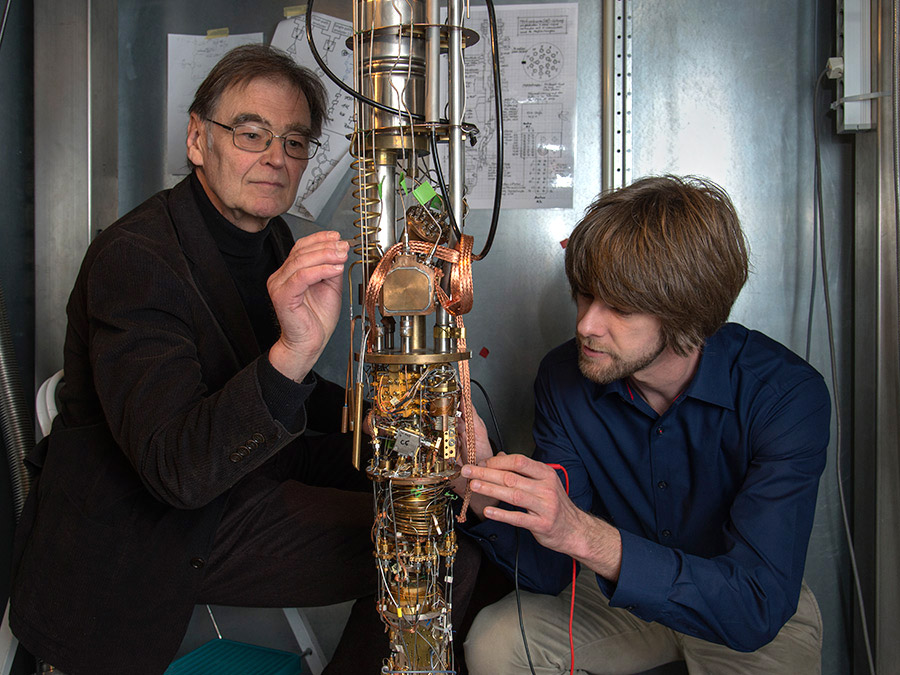Interplay of magnetism, nuclear spin, and superconductivity
Superconductivity in the land of the "heavy fermions"

Superconductors transport electrical current completely without resistance and are therefore of high interest for technology. While there is a physical explanation for classical superconductivity, it is not yet clear how the phenomenon comes about in high-temperature superconductors. Researchers worldwide are searching for models and examples that could explain it and bring them closer to the long-term goal of achieving room-temperature superconductivity.
Now a mechanism by which superconductivity arises at low temperatures in a compound of ytterbium, rhodium, and silicon (YbRh2Si2) has been discovered by an international team: Prof. Erwin Schuberth of TUM and the Walther Meissner Institute of the Bavarian Academy of Sciences, Prof. Frank Steglich, director of the Max Planck Institute for Chemical Physics of Solids in Dresden, Prof. Qimiao Si of Rice University, and Prof. Rong Yu of Renmin University.
In the land of the “heavy fermions”
In contrast to neutrons and protons, the building blocks of the atomic nucleus, electrons are extremely light. They belong to the class of particles known as fermions. In special materials and under particular conditions, though, they behave as if they were a thousand times heavier. The intermetallic compound of ytterbium, rhodium, and silicon that the researchers investigated is a typical representative of such a material, a so-called heavy-fermion system.
“There is already compelling evidence that unconventional superconductivity is linked, in both copper-based and iron-based high-temperature superconductors, to quantum fluctuations that alter the magnetic order of the materials at 'quantum critical points,' watershed thresholds that mark the transition from one quantum phase to another,” Qimao Si says. “This work provides the first evidence that similar processes bring about superconductivity in heavy-fermion systems.”
Ultralow temperatures
In Frank Steglich's research group, heavy-fermion systems such as the ytterbium-rhodium-silicide have been intensively studied for more than 15 years. In earlier investigations, an external magnetic field enabled the researchers to obtain quantum fluctuations but inhibited the transition to superconductivity.
For their new experiments, the scientists used a nuclear demagnetization cryostat at the Bavarian Academy of Science’s Walther Meissner Institute in Garching. This device can cool samples down to a temperature of 400 millionths of a degree Kelvin. At a transition temperature of two millikelvin, the samples suddenly became superconducting.
In specific-heat measurements, the study's authors were surprised to see that the effective mass of the charge carriers in their compound appeared to increase by a further factor of 1000 when the material was cooled below the superconducting transition temperature. “That shows clearly that in the domain of ultralow temperatures, interactions with the nuclear spin of the surrounding atoms are at work,” says Erwin Schuberth. “They form a magnetic order that makes superconductivity possible.”
Nuclear spins rearrange themselves
When theorists Qimiao Si and Rong Yu analyzed the measurement results, they found that the prerequisite for the superconductivity is a special arrangement of the nuclear spins of the ytterbium. According to their theory, at extremely low temperatures the nuclear spins link up and arrange themselves in a manner that competes with and decisively weakens the antimagnetic electronic order. In this way, the electronic “quantum critical” fluctuations come to bear – the driving force for the superconductivity.
“This work shows that the emergence of nonclassical superconductivity in the vicinity of antiferromagnetic instabilities is a general phenomenon,” says Frank Steglich. “It is not confined to the cuprates and organic superconductors, but also occurs in the heavy-fermion materials, model substances for quantum materials with extremely strong electronic correlations.”
This research was supported by the German Research Foundation (DFG), the Robert A. Welch Foundation, and the National Science Foundation (NSF).
Publication:
Emergence of superconductivity in the canonical heavy-electron metal YbRh2Si2
Erwin Schuberth, Marc Tippmann, Lucia Steinke, Stefan Lausberg, Alexander Steppke, Manuel Brando, Cornelius Krellner, Christoph Geibel, Rong Yu, Qimiao Si, Frank Steglich; Science, 29.01.2016 – DOI: 10.1126/science.aaa9733
Contact:
Prof. Dr. Erwin Schuberth
Technical University Munich
Chair for Technical Physics (E23)
Walther-Meißner-Str. 8, 85748 Garching, Germany
E-Mail